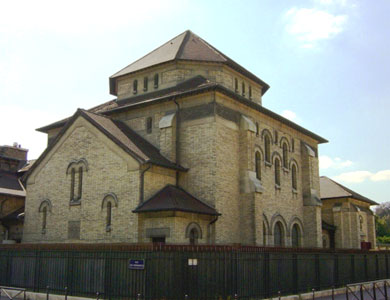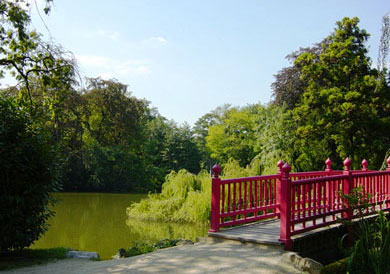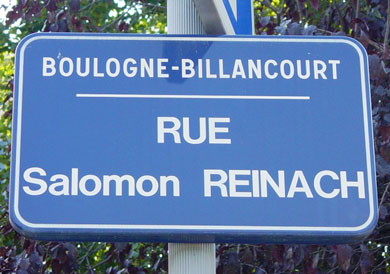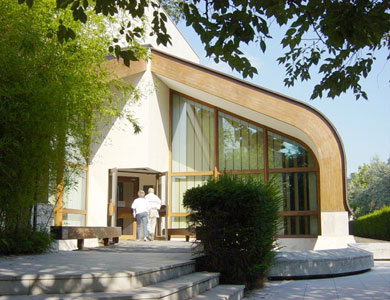A Legacy of Jewish Artists and Patrons in a Paris Suburb
 |
Visitors to Paris know that the place to enjoy strudel or a kosher meal is the famous Jewish Quarter in the heart of the city. But the Jewish community has also made its mark in the surrounding towns, and there are a number of architectural and cultural treasures worth finding.
In many ways the history of the Jews of France reflects the social
and artistic developments of the country as a whole. Until the late
19th century, Paris' Jewish community was an urban phenomenon,
centered in the capital's medieval Marais district. The development
of suburban communities represented not only the city's expansion, but
also the social and financial advancement of Parisian Jews. By the
1880s, a period of peace and prosperity in France after the wounds
inflicted by the Franco-Prussian War, synagogues began to appear in
the affluent western suburbs of Neuilly and Versailles.
The Jewish community of neighboring Boulogne, consisting of twenty or
thirty families, soon outgrew the rented space used for prayer and
began to make plans for the construction of its own synagogue. The
generosity of the Baron Edmond and Baroness Adelaide de Rothschild
made this dream a reality. The Rothschilds donated a part of their large estate, enlisted the renowned architect Emmanuel-Elisée Pontremoli, and provided continued support for the project. Byzantine in style, imbued with a simple elegance, Boulogne's synagogue was inaugurated in 1911.
As the town grew and prospered, so did the Jewish community, enriched by new arrivals from Paris, as well as refugees from the pogroms in Eastern Europe. But the Second World War and the Nazi occupation decimated Boulogne's Jewish population. The town had its share of deportations and humiliations. Of a hundred Jewish families, barely fifteen survived. For a few years during the war, Pontremoli's elegant synagogue was used by the Nazis as a stable.
"In 1945," wrote Claude Bloch, Honorary President of the Community, "our synagogue was neither flourishing nor joyous. The building had suffered damage in the war, and as for the community... The first Hanukkah after the Shoah was pitiful:shattered families, frightened children huddling around little candles, as if for warmth, sadness and despair in the survivors' hearts."
With the independence of Algeria in 1962, France saw massive waves of immigration from its former colonies in North Africa. The influx of Sephardic Jews enlarged and rejuvinated the Boulogne community. Customs and worship changed as what had been a largely Ashkenazi congregation integrated the Sephardic newcomers. By the 1990s, the community numbered about a thousand families.
The Rothschild estate is now the Edmond de Rothschild Park, open to the public. A few blocks away, "la rue Salomon Reinach" marks the street where Reinach, one of a family of scholars, opened his extensive personal library to intellectuals and writers like Thomas Mann.
 Rothschild Park - © M. Petringa |
 © M. Petringa |
Possibly Boulogne's most distinguished Jewish resident was the banker and philanthropist Albert Kahn. After a lucrative career in finance, Kahn spent his later years developing a utopian philosophy of a world in harmony, and doing all he could to bring it about.
Arriving in Paris in 1879 from his native Alsace, Kahn found success in the world of banking. By 1895 Kahn, aged 35, was considered one of the most important financiers in Europe. In his spare time he took a great interest in music and the arts and befriended the sculptor Auguste Rodin, the philosopher Henri Bergson, and many other artists and writers.
As the 20th century approached, Kahn thought it essential to encourage a greater mutual understanding of the world's different cultures. In 1898 he created the "Around the World Scholarships" for recent graduates of France's finest universities. Kahn encouraged his protégés to reject commonplace ideas and prejudices and to experience the ever-changing variety of foreign lands for themselves. The young scholars traveled, wrote, took photographs, made films. When they returned to France, they spoke about their travels at Kahn's home in Boulogne. In 1906 Kahn established the "Around the World Club", a growing circle of intellectuals who came to Boulogne to exhange ideas on civilizations around the world.
 |
But the project closest to Albert Kahn's heart was his garden. In keeping with his philosophy of a world in harmony, he turned his property in Boulogne into a mosaic of the world's gardens, including an orchard, a prairie, a pine forest, a Japanese garden complete with tea pavilion, an English garden, and a formal French garden with a variety of roses. A greenhouse was built for tropical plants. On Sundays, Kahn would invite distinguished guests to enjoy his "world in miniature".
These days the Albert Kahn Museum and Garden is a popular outing for Parisians and tourists. His "Archives of the Planet" have been incorporated into a modern audiovisual system, making them easily accessible to future generations.
As with Pontremoli the architect, Rothschild the benefactor, Reinach the scholar, and many other Jewish residents of Boulogne, Albert Kahn's life and work have become a lasting and well-loved contribution to metropolitan Paris' cultural scene.
 |